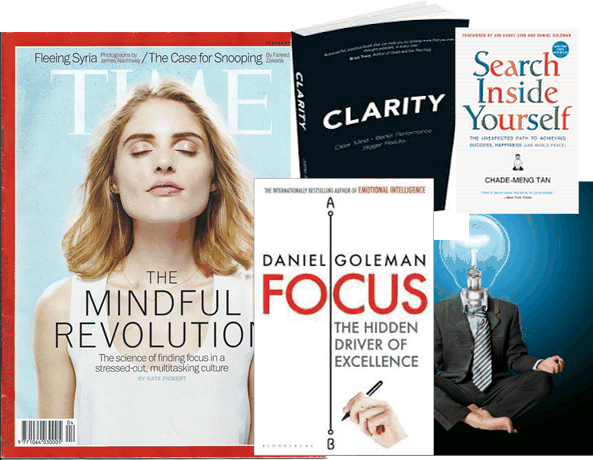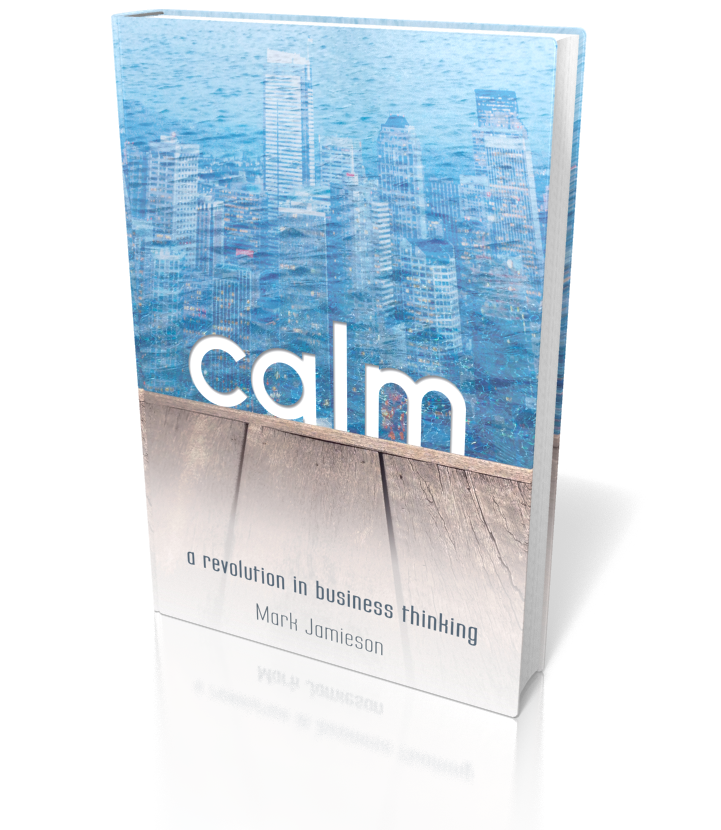A Revolution In Business Thinking
Everyone wants a little more time, a bit more mental space, some more balance in their life, a little more clarity in their work. This book shows you how.
Ended
It all seems an impossible dream. With over $14 Billion dollars spent on leadership training annually in the US alone, the need to develop our skills in the workplace is well recognized. But it also recognized that most of the training doesn't hit the spot. Why not? Because it doesn't address the root cause of the issue: the way we think about things. If you keep on doing what you've always done, you’ll get what you've always got. Does that sound familiar? If you keep on thinking the same way, things are not going to change.

Mindfulness is a hot topic in the business world today. It holds out the hope that finally we can consistently achieve a bit more focus, clarity and purpose in our business dealings by understanding at a deeper level just what is going on
But in truth, most approaches focus on getting calm, but don’t help us stay calm when trapped in the middle of the pressures of the business world. That’s where the calm™ approach comes in: practical approaches and techniques to act mindfully at work as well as being mindful at rest.
But with all this talk of mindfulness in business, it is sometimes not clear what exactly it is. Let's start with a helpful definition of mindfulness:
Mindfulness is the awareness of our thinking and its impact on ourselves and others.
We get mindful when we calm down. To stay mindful is another matter. The calm approach helps you work out what is really going on in everyone's heads.
Throughout my career I have helped organisations solve business issues by getting to the root cause of the problem. And, importantly, I’ve also been responsible for fixing the problem. Advice is easy to give if you don’t have skin in the game. I had to find out what really works. Fifteen years ago I came across a secular, logical understanding of mindfulness called the three principles of mind, consciousness and thought. They promise to revolutionize the way we work and the way we think about our work. I developed, with others, a series of approaches that enable us to act mindfully at all times, as well as being mindful when we are resting.. These approaches have been tried out and refined in some of the most difficult business conditions in the world. Now they are ready for a wider stage.

I wrote this book for anyone who not just wants to cope with the stresses of work but also wants to thrive. My aim is to help you make sense of things so you can have clarity about what is going on, so you can focus on what is important and achieve what you really need to achieve. It’s not just talk and its not just play. It is deeply practical and provides step by step guidance. Its not just about getting calm, its about staying calm as a way of life.
The Publishizer campaign is designed to do the book justice. The people who have previewed the book are adamant that the book deserves the effort to turn in into a final polished product. And you can help: by reviewing the book and helping shape the final version, and, of course, by helping fund the publishing activities.


With his degree in Psychology and MBA, Mark has always been interested in the psychological aspects of our work life. His career in management has included senior positions at IBM, Ernst & Young, PeopleSoft, Ernst&Young, and Oracle.
Mark's focus has often been on the most practical aspects of management: how to get people to do what they are supposed to do.
In 2001, he came across a model of human experience called The Three Principles of Mind, Thought & Consciousness. This provided the missing link to solving previously intractable problems in business. It is a secular, logical, practical model of how we create our own reality and interact with the world.
Inspired by this, Mark developed the CALM approach to remaining centered and focused in the workplace and in life in general.
Now based in Singapore, Mark Jamieson devotes his time to inculcating this motto across the corporate world.
Deeply Practical Book
You’ll find this deeply practical book is filled with information about how to become and remain mindful in your working life. Here’s what you’ll discover in each chapter:
Chapter 1: For Goodness Sake, CALM DOWN!
In this chapter, I tell the story of a pre-CALM business failure and how I discovered The Three Principles that gave me the key to preventing such failures. The chapter discusses what it means to calm down, why that’s useful, and how we can achieve this state. It explains how the CALM approach came into being and introduces one surefire way to calm down in every situation: To get listened to. You’ll find out how this works, and the four main stages, or aspects, of CALM.
Chapter 2: Find the Root CAUSE
You’re calm and that’s great. But now what? The point in business is to do something and do it mindfully. First you need to find the root cause of an issue because if you don’t, the issue will return again and again. And, yes, the first great secret is that the root cause of any issue is our thinking. In this chapter, you’ll discover approaches and techniques (including our Insight Generator) to not only find the root cause but also the underlying thinking and reinforcers that created it.
Chapter 3: Be AWARE of How You Think
The second great secret is this: You are the author of your experience which means, of course, you are the only person who can change it. But if you want to change your thinking, you first need to know how it works. In this chapter, you’ll go deeper into the Three Principles and explore how you use them to create your experience as a unique human being.
Chapter 4: LET It Go
The third great secret is this: Accessing insight and wisdom requires that you deliberately not think. Identifying the issue is seminal, but the great coaches can also help you understand how to resolve the issue yourself. The key is to let go of what’s bothering you and allow your innate wisdom and insight to do the rest. How? To get listened to. Chapter 4 goes more deeply into this critical aspect of becoming calm and clear. You’ll learn how to perform this important act of service to truly listen to someone.
Chapter 5: Get in the Right Mood
This chapter reveals the fourth great secret that is, rather than focus on your thinking, you want to focus on your mood.
Typically, we’re taught in business that emotions should be discounted, controlled, or ignored altogether. But using the CALM approach, they’re the key to staying mindful at all times.
Check out the powerful relationship between mood and mindset. Using the Mood Mapper in this chapter, you’ll see how your own mood has a powerful effect on others. You’ll discover how far you can cast your shadow and your light.
The remaining chapters show you how to apply the CALM approach to a few typical hand until now often intractable business problems.
Chapter 6: From There to Here
Unlock the secret to getting things done in your organization by being and acting mindfully. Help everyone become clear about exactly what to do.
Chapter 7: From Calm to Calmer
You can present details and processes until your eyes cross. But in any project, people have to know what is theirs to do and take ownership to do it. They also require the time and space to work it out for themselves rather than be told. This chapter explains the key of ownership
Chapter 8: Less Stress, More Success
Once you get going, it’s good to keep going. This chapter helps you understand the true causes of stress and why it benefits you to reduce it. You’ll discover how to access your innate resilience to see you through any situation.
Chapter 9: Transformed Meetings
If one thing dominated our work lives, it’s meetings. You’ll learn to understand the key to a successful meeting that is, paying attention to the tone.
Chapter 10: Putting Off Procrastination
Everyone everyone has trouble at times doing what he or she is supposed to do. This chapter reveals surprising advantages of procrastination and how to be mindful of what putting off a task tells you. You’ll understand the role of thought and use the CALM approach to sort out the whole sorry mess.
Chapter 11: Pollyanna Was Right
From three simple principles Mind, Thought, and Consciousness a new world opens up. It may seem too good to be true, but it is true. This chapter addresses frequently asked questions or concerns about CALM.
Sample chapter - try a bit of calm
Before enlightenment, chop wood, carry water. After enlightenment, chop wood, carry water. – Zen Proverb
Imagine you’re on a flight from Singapore to Sydney in a nearly brand new Airbus A-380. Your mind isn’t focused on the miracle of sipping champagne and finishing a canapé on a reclining leather seat 20,000 feet in the air. Instead, you’re preoccupied with work you need to complete while on the flight. You appreciate the extra space so you can type on your PC and catch up.
Suddenly you hear a bang. Then a second later, a louder one shakes the whole airplane. What sounds like thousands of pieces of shrapnel rattle across the fuselage. The plane lurches, then steadies. You don’t panic, but you don’t know what to think. You look out the window and see an engine on fire. You scan the wing anxiously and notice parts of it are missing. The hum of the plane’s engines becomes inconsistent, and the plane zigzags.
You quickly inventory your life, and it comes up short. No time for regrets, but if you’d known you had such an uncertain future, you’d have made a few amends and changes not regarding your work, but your loved ones. Work is no longer important.
For 440 passengers and 29 crew members of Qantas Flight 32 on November 4, 2010, this nightmare situation was reality. The inside port engine had exploded as the plane climbed out of Singapore, setting off 54 simultaneous warning messages for the cockpit crew. Focusing first on keeping the plane in the air, the captain and crew had to determine how to land it with flight control software not designed to deal with this flying configuration. In addition, the plane had no antilock brakes. The flaps and hydraulics were damaged, and the landing gear wouldn’t lower. At first, the flight control computer was unable to calculate the landing distance required. On the second try, it indicated the plane needed all but the last 100 meters of the runway, provided the crew could fly the crippled plane precisely and at the exact speed needed to touch down safely.
As a passenger in that plane, would you prefer the pilot and crew didn’t panic but instead remain truly calm and focused?
In his book QF32, Captain Richard de Crespigny described how he managed this crisis. The situation was so complex that the safe landing of the airplane and survival of all passengers and crew has been described as a miracle.
Being calm was the prerequisite. This mental and emotional state allowed the captain and crew to focus on the right things and not get distracted by the wrong things. They could then use various processes effectively and create innovative solutions to situations they hadn’t foreseen or had never before experienced.
This state is the calm discussed in this book. Not merely relaxation, calm is the ability to take the right action at the right time, even under extreme pressure. This is mindfulness at work.
Take the pressure off?
But what about when we are not under pressure? Are we calm then? For most people who work, even when the pressure is not intense, they still can’t find that calm centered place. Sometimes they even welcome a crisis because it is only then that they truly feel alive. But this is not a sustainable way to run a business, or your life. Even without external pressures, our internal world seems busy and distracted. This basic sense of lack, of incompleteness seems only to be relieved when we take action, so that is what we do: activity, distraction, busyness, anything to overcome that basic feeling of things not being right.
All That Training But . . .
The corporate world collectively spends billions on training, including personality profiling, team building, corporate retreats, creativity conferences, counseling, coaching, getting to know yourself, getting to know others the list is endless. Our appetite for improvement is immense, but we’re still not satisfied. U.S. companies alone spend almost $14 billion annually on leadership development, yet only seven percent of senior managers think their leaders are able to develop leaders for a global economy effectively. All that training, and we’re missing the mark.
And now “mindfulness” has taken the lead, but it still doesn’t solve our problems. Why not? Because solving our problems requires action, not just contemplation. Although mindfulness can help us calm down, see the big picture, and quiet some of the noise, being in business requires we do something. Yes, we’re expected to produce something and our performance be measured by finite results.
The concept of mindfulness is currently being bandied about in business without much clarity around its meaning. The term seems deliberately loose and vague, expressed in such phrases as a happy feeling, a sense of peace, or a heightened awareness. Yet mindfulness can be too easily shattered as soon as we get back to work.
What is Mindfulness?
Mindfulness is about our thinking: being aware of our thinking, sensing when it leads us astray, knowing when we’re on the right path. We’re doing the right thing, not just doing things right. After all, aren’t we paid to do clear thinking?
Sidebar
Organizations with people who can think mindfully are the ones that succeed. Mindfulness is being aware of your thinking and its impact on you and others.
End sidebar
As the story of Qantas Flight 32 demonstrates, being calm is the prerequisite to clear thinking. So achieving a sense of calm even under pressure is this goal.
Honestly, most of us can use more calm in our lives. But many find it difficult to be in a calm state even when we’re expected to be for example, when we’re on vacation. We may seem outwardly calm but internally, we’re in turmoil. How could we possibly perform at our best without it?
We have real issues in our lives that need to be addressed, and they don’t magically go away when we sit still in meditation to become calm. These issues involve work pressures, money, relationships, health and all needing to be addressed. It’s easy to be calm when we’ve put these issues aside. But how can we stay mindful even under all the pressures of work and life in general? More than that, how can we act mindfully at all times?
When faced with his QF32 crisis, Captain de Crespigny didn’t have time to enjoy a 10-minute meditation nor do a two-minute focused breathing exercise. Similarly, we can’t call a time-out during a tense business meeting, go to a quiet room, and come back 10 minutes later. We have to respond to what’s in front of us immediately but in a mindful way.
Business has always been about results, whether it concerns profitability or other more nebulous measures. That pressure never goes away to constantly thrive in a business environment and always deliver results. We don’t do that by sitting still.
An Approach to Finding the Root Causes of Issues
Captain de Crespigny had to uncover the underlying cause producing those 54 warning messages so he could land the plane safely. He couldn’t rely on the warning messages: there were too many to deal with and most of them were misleading. He had to remain calm.
The CALM™ approach, the subject of this book, addresses four key stages of getting and maintaining calm. It starts with finding the root causes of issues. If we don’t address the cause, the issues will keep coming back. Sound familiar?
For us, the root cause of our business issues always relates to the way we think. If we don’t understand our underlying thinking, it will be difficult to change situations or resolve issues. There is growing agreement on this point, as evidenced by this report from McKinsey:
Looking inward is a way to examine your own modes of operating to learn what makes you tick. Individuals have their own inner lives, populated by their beliefs, priorities, aspirations, values, and fears. These interior elements vary from one person to the next, directing people to take different actions.
Interestingly, many people aren’t aware that the choices they make are extensions of the reality that operates in their hearts and minds. Indeed, you can live your whole life without understanding the inner dynamics that drive what you do and say. Yet it’s crucial that those who seek to lead powerfully and effectively look at their internal experiences, precisely because they direct how you take action, whether you know it or not. Taking accountability as a leader today includes understanding your motivations and other inner drives.[1]
Uncover Our Thinking
Yes, understanding how we think is crucial, and once we uncover its power, change becomes surprisingly easy. Thus, it’s time to address the following three aspects of our thinking:
1.The underlying principles of how we think. Almost every approach, mindful or not, treats thought as something to be dealt with as necessary when it arises. We’re generally not told how we came up with the thought in the first place. This book explains clearly and logically how we are truly the authors of our own experience.
2.How to change our thinking. Change is all about letting go so our innate intelligence can shine through. It’s not about doing more thinking; it’s about accessing the right thinking.
3.How to stay in that mindful place. How can we hang out there even when we’re working? This book explains the surprising impact of mood, both individual and collective, on an organization’s performance, and the benefit for everyone of maintaining a calm, mindful state.
The Origins of the CALM Approach
I was not always calm. Born with a “nervous disposition” that showed up as a drive to succeed and a focus on detail, I wanted to ensure nothing “untoward” happened. Although these were useful attributes in my early career at IBM and other computer companies, I then moved into management consulting. In this field, I discovered something interesting and useful: If I was calm, then others around me became calm, and we could make great progress. Once we were given a little time and space to examine the problems at hand, answers that first seemed intractable became obvious and clear. (Of course, it’s easier for consultants as outsiders to do this; consultants offer advice but don’t have to live with the consequences.)
From this clarity excellent ideas were sparked. So I asked, “If the benefits of being calm were so clear, what would happen if we became even calmer?” For me, this thought initiated a decades-long search for deeper peace and calm through mindfulness practice.
My Being was Calm, Finally
I finally reached a point in which my being was calm. In fact, extremely calm. Almost too calm. I had come to the end of a 10-day silent meditation retreat. I had arisen at 4:30 a.m. every morning and either meditated or rested all day. Mainly I had meditated free of contact with anyone. It was just me, trying not to think.
How hard was it? Let me draw comparisons from my own life. Specifically, I had ski-toured across the European Alps where falling over the edge would have meant a rapid vertical descent of 1,000 meters (landing on rocks at the bottom). I’d been arrested and detained at a Turkish border checkpoint (I’d watched a movie about this called Midnight Express a year earlier so I was scared). I’d stolen a flag from the headquarters of the revolutionary guard in Iran (and I tell my children to be especially sensible!). I’d sailed two Fastnet yachting races (but only completed one because our yacht started sinking in the other) and completed an Ironman triathlon run, swim, bicycle. Plus, I tried to give the kiss of life to a dead man we had rescued in a storm in the English Channel. (Unlike a movie’s Hollywood ending, he didn’t recover.)
Yet despite all of these hair-raising adventures, the silent meditation retreat was the most difficult thing I’d ever done. I sat still, alone, with nothing but my thoughts. For many people, that is their worst fear: To find out who they truly are just as I did during that retreat.
Find Our True Nature
It takes a while for our minds to calm down, to let the buzz of our constant thinking die away, to allow our innate, peace-seeking nature to shine through. When freed from chasing our thoughts, we’ll find our true nature is one of completeness, wholeness, and innate health. We are an integral part of everything.
Yes, the enlightenment experience I’d been chasing had occurred. As my mentor Bob Adamson said when we talked about this, “The mind is highly creative. No wonder you experienced all sorts of things sitting still for ten days.”
When my retreat was over, it was time to speak again, but I had nothing to say. In the car returning to the city, everything looked vivid, bright, and new to me. But the people we passed all of them looked burdened, so burdened, by their thoughts. It was as if they were weighed down by heavy wet burlap sacks full of memories, hopes, and fears, while I felt light and free. I knew I could live the monastic life and stay light and unconcerned. My experiences could only get better!
But I also knew my place was back in the world of family, friends, and work.
Achieving the Impossible
And what work it was: fast paced, pressured, with big projects and tight deadlines for global IT companies, seemingly achieving the impossible time after time. My cadre of fellow project managers lived with pressure and stress, and one by one, they succumbed to their effects. We joked at IBM that this acronym stood for “I’ve Been Married,” but that was too close to the truth to be a good joke!
In this pressure cooker, I kept working while still recalling the peace and calm of my meditative practices. But I slowly became overwhelmed. I questioned whether what I’d learned was the truth after all. For something to be true, it needed to be true all the time, in all places. That meant it had to be as valid in the workplace as on the retreat.
Mindfulness practices did seem to offer a quick respite, a slice of peace here and there. But work seemed crazy. It was as if I had one set of thoughts when I was resting in mindfulness and another rigid, frantic, rushed set when I was working. My colleagues and I talked about work-life balance this way: Work is onerous, stressful, and frantic, while life is recovering from it only to return to the craziness each Monday. Most unsatisfactory!
The Three Principles of Mind, Thought, and Consciousness
But then I came across something that seemed too incredible to be true. It continues to be incredible to this day except it makes inherent sense. I discovered a secular, logical explanation of mindfulness called the Three Principles of Mind, Thought, and Consciousness.[2] These underlying principles explain how we experience the world, why we do what we do, and why others do what they do. They represent the logic of the psyche, or to be more precise, the underlying principles of psychology. The answer I was seeking was not in the world of mysticism; it was back in the world of the first practice I had used to explore our mental world psychology.
I felt determined to see if these Three Principles worked in the workplace, and they did!
A project is a microcosm of an organization, with virtually every function replicated on a smaller, understandable scale. Each project provides an open laboratory in which we can see what works and what doesn’t, with all activities contributing to a measurable goal. They are full of stress, opportunities for mistrust, miscommunication, and outright organized resistance.
I tried these principles while running my projects, and we learned we could turn around any troubled project in three weeks to meet its original timeframe, scope, and budget. These principles based on identifying the underlying thinking that causes any issue lend themselves to practical and profoundly effective ways to address these issues through mindfulness.
But you might say, “Surely changing thinking is the hardest thing in the world.” No, it actually isn’t hard to change thinking that is, not if you know how you created a thought in the first place.
Inspired by this train of thought, I developed, tested, shared, and finally created the CALM approach. These concepts of Practical Mindfulness™[3] draw on the experience of many business consultants who operate from an understanding of these principles. In particular, Alexander Caillet of the Accompli group introduced me to many of the exercises in this book and graciously allows me to use them. We both have the same view: The more people understand how their thinking affects everything they do, the better place the world will be.
[1] Nate Boaz and Erica Ariel Fox, “Change Leader, Change Thyself,” McKinsey Quarterly, March 2014.
[2]Sydney Banks, The Missing Link: Reflections on Philosophy & Spirit, International Human Relations Consultants Inc., 1998

Mark Jamieson has worked in senior management positions for some of the world's leading organisations. During this time, the same basic workplace problems occurred repeatedly: busy-mindedness, lack of clarity, poor communication and stress – all symptoms of a lack of inner calm. These issues have seemed intractable until now. Mark has developed the unique and powerful CALM approach, using mindfulness to finally help solve these chronic workplace issues.

Barbara McNichol has worked with 200+ amazing authors since she founded Barbara McNichol Editorial in 1994. She is passionately committed to helping authors achieve accuracy and artistry, clarity and creativity through the written word. Barbara delivers expert editing that puts your book on the pedestal it deserves.

Sheamus Burns is providing book cover design and book layout for Calm. Sheamus is a graphic designer based in NJ, USA. He’s worked with a range of clients to produce logos, promotional graphics, posters, books, and music albums for both print and web. He also is a practicing fine artist who makes drawings, paintings, and sculptures.
The author hasn't added any updates, yet.
$10
72 readers
Receive calm as an eBook, plus an invitation to the exclusive soft-launch event.
Includes:
$25
105 readers
Own a copy of calm, plus an invitation to the exclusive soft-launch event. You'll also have access to the latest electronic version and can contribute to the final product.
Includes:
$40
6 readers
You probably know someone that needs to get calm. Keep one copy and give the other away. You'll also have access to the latest electronic version and can contribute to the final product, plus 2 invitations to the exclusive soft-launch event.
Includes:
$100
12 readers
Be a founding member of the calm revolution and receive a beautifully presented, signed hardcover edition of the book, plus an invitation to the exclusive soft-launch event. You'll be acknowledged in the book as a founding member of the calm revolution.
Includes:
$500
1 reader
Solve a pressing business issue! You will receive 5 signed hardcovers and a 90-minute Skype coaching session for your team. You'll also be thanked and acknowledged in the book.
Includes:
$2500
0 readers
Get the ultimate calm experience for your organization. This pack includes 20 hardcover books and a 60 minute strategic onsite keynote, customized to your organization's unique issues, presented by the author, Mark Jamieson. All supporters will be named and thanked in the acknowledgements.
Includes: